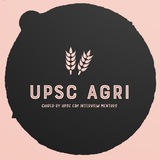Forwarded from UPSC Agriculture Optional IARI
https://youtu.be/P3FoC90QHfw?si=UrBOFYBzLz2AzLFD
For those who require Motivation👍
For those who require Motivation👍
YouTube
Nitesh Mishra, AIR 158, Agri Optional-274(2023),309(2018)-How to score 300+ in Agriculture Optional?
https://t.me/Agriculture_OptionalUPSC
#Agriculture optional #UPSC
#Agriculture optional #UPSC
Make the best use of this channel for guidance by Apsara AIR 192
https://t.me/apsara192
https://t.me/apsara192
Telegram
Apsara, AIR-192 CSE-2024
Hello all, I am Apsara, my optional is agriculture. This group is an opportunity to give back to the community.
For queries, please mail, apsara.n192@gmail.com
For queries, please mail, apsara.n192@gmail.com
Scientist Whose Biological Seed Treatments Helped Make Brazil A Global Breadbasket Named 2025 World Food Prize Laureate
https://www.linkedin.com/pulse/scientist-whose-biological-seed-treatments-hcsqf?utm_source=share&utm_medium=member_android&utm_campaign=share_via
can we replicate such a wide use of bio-inoculants in India?
https://www.linkedin.com/pulse/scientist-whose-biological-seed-treatments-hcsqf?utm_source=share&utm_medium=member_android&utm_campaign=share_via
can we replicate such a wide use of bio-inoculants in India?
Linkedin
Scientist Whose Biological Seed Treatments Helped Make Brazil A Global Breadbasket Named 2025 World Food Prize Laureate
Dr. Mariangela Hungria will receive the $500,000 award for her work to harness biological processes to sustainably improve crop nutrition, yields and productivity.
Important for Prelims :
What is SDN 1/2/3
SDN (Site-Directed Nuclease) is a genome editing technology categorized into SDN-1, SDN-2, and SDN-3 based on the nature of the edits introduced. SDN-1 involves small insertions/deletions without foreign DNA, SDN-2 uses a small DNA template for specific changes, and SDN-3 introduces larger DNA elements or genes. Government documents often discuss SDN, particularly in the context of regulating genome-edited plants.
What is SDN 1/2/3
SDN (Site-Directed Nuclease) is a genome editing technology categorized into SDN-1, SDN-2, and SDN-3 based on the nature of the edits introduced. SDN-1 involves small insertions/deletions without foreign DNA, SDN-2 uses a small DNA template for specific changes, and SDN-3 introduces larger DNA elements or genes. Government documents often discuss SDN, particularly in the context of regulating genome-edited plants.
# Prelims Important
Speed breeding is a technique that accelerates plant development and crop breeding by manipulating environmental conditions and other methods to shorten the time it takes to advance a crop from one generation to the next. This process, also known as rapid generation advancement, relies on techniques like controlled environments, prolonged photoperiods, and high-density planting to hasten flowering, seed development, and maturity.
Speed breeding is a technique that accelerates plant development and crop breeding by manipulating environmental conditions and other methods to shorten the time it takes to advance a crop from one generation to the next. This process, also known as rapid generation advancement, relies on techniques like controlled environments, prolonged photoperiods, and high-density planting to hasten flowering, seed development, and maturity.
FR-IFSM-2024-Engl-190525.pdf
113.3 KB
IFS results 2024 batch
